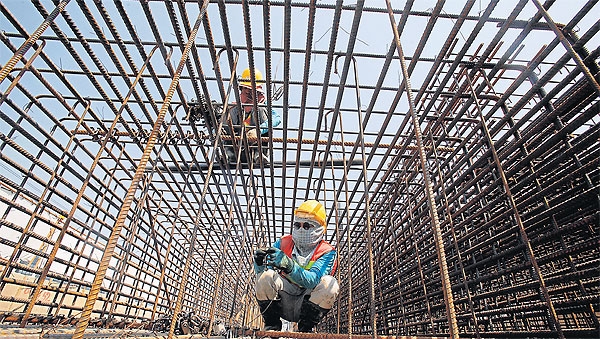Jobless rate tightly anchored
- Published: Feb 4, 2015 06:00
- Writer: Post Reporters | 1 viewed
A mere 0.56% — that's Thailand's official unemployment rate as of year-end 2014. It's among the lowest in the world, and compares with 9.4% in India and 6% in the Philippines within the region.

Workers bind steel at a construction site of the Red Line connecting Bang Sue in Bangkok to Rangsit in Pathum Thani. Thailand's official jobless rate of 0.56% is among the world's lowest. PATTARAPONG CHATPATTARASILL
This is not a recent phenomenon: Thailand's jobless rate has held below 1% for the most part since 2011. The record high was 5.73% in January 2001, when the National Statistical Office first began releasing the data every month.
How did it get so low?
"Our unemployment rate has been low not because of a different definition from other countries, but because of structural problems," said Bank of Thailand spokesman Chirathep Senivongs Na Ayudhya.
"The agricultural sector absorbs labourers, and those who can't find work can always look for jobs in the informal sector or do something on their own."
No free lunch: Because there isn't much by way of unemployment insurance in Thailand, there isn't any impetus to stay jobless for long. Those who lose their jobs invariably enter the so-called informal sector or seek out a part-time job, and are counted as employed.
Farmhands: More than 40% of Thailand's population is engaged in agriculture, where there is a high degree of underemployment and off-season unemployment. The underemployed are counted among the employed and make up about 0.5% of that total. If, for instance, you lose your job as a bank teller and return home and lend a hand at your dad's farm for at least one hour a week, you are considered employed.
Too few babies: Thailand's fertility rate for 2010-15 is estimated at 1.4 by the United Nations Population Fund, compared with 3.4 in the Philippines. Plus, its population aged 60 years and above rose to about 15% last year from under 7% in 1994, so there are more people retiring and fewer joining the workforce. In comparison, Japan, where more than a quarter of the population is over 65, has a jobless rate of above 3%.
Foreign workers: While there may be up to 3 million migrant workers in Thailand from Cambodia, Laos and Myanmar, according to Human Rights Watch, they are mostly undocumented. The government is taking steps to register foreign workers, but the language barrier is a challenge to increasing their numbers in more skilled sectors.
Shades of grey: The informal sector of the Thai economy, comprising anyone who's not covered by formal work arrangements, accounted for more than 64% of the total workforce in 2013. It includes street vendors and motorbike-taxi drivers, the self-employed, and those operating in grey areas of the economy. They are largely counted as employed.
With no major labour-market policy changes planned and with inflation falling in January for the first time since 2009, there are no signs that the government or the monetary authority is unduly worried about the jobless rate. So that rate is going to stay very low. Bloomberg


